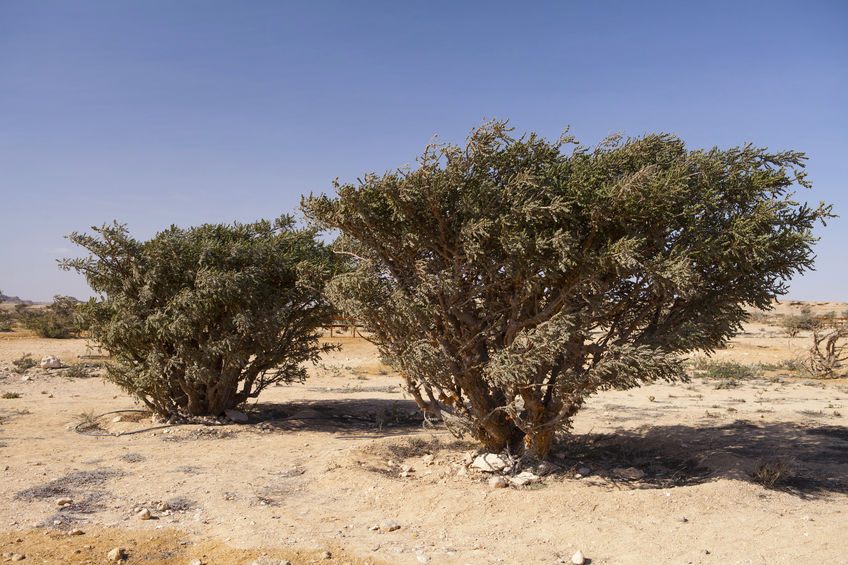Indian Frankincense - Boswellia serrata

Common Names: Indian Frankincense, Boswellia, Salai Guggul, Sallaki, Punjab tree, Boswellia serrata, Frankincense, Olibanum, Salai, Shallaki, Frankincense tree, Salai resin, Salai gum, Global: Boswellia, Latin: Boswellia serrata, Origin: Indian Frankincense, English: Frankincense
Latin Name: Boswellia serrata
Origin: Africa
Short Introduction
Boswellia is a typical tree of subtropical and tropical regions. Its advantage lies in its ability to thrive in poor soil environments with annual rainfall between 500–1250 mm. The tree is particularly valuable for afforestation of barren or plant-deficient areas.
Detailed Description
An exotic plant with strong ritual and spiritual significance.
Botanical Information
Indian Frankincense, or Boswellia, is a medium-sized tree typically reaching about 2 meters in height, though some varieties can grow up to 8 meters. It features pinnate, petiolated leaves with serrated edges that grow in clusters. The upper surface of the leaves is notably darker. The flowers are small, ranging from white to pale yellow. The fruit is a small capsule, usually less than one centimeter long. When the bark is incised, the plant releases a yellow aromatic liquid—its signature resin.
Origin and Distribution
Indian Frankincense originates from the Arabian Peninsula and regions along the Red Sea coast. Due to its popularity, it quickly spread to the Indian subcontinent and Africa.
Usage / Dosage
Historically, the plant is renowned for its resin, known as frankincense, used in religious and various ritual ceremonies, including Christian church rites. The resin is harvested by cutting the tree trunk and collecting the exudate in special bamboo baskets. Frankincense has the oldest documented uses in fumigating or embalming practices dating back to ancient Egypt, Babylon, Persia, China, Greece, Rome, India, and even among Native Americans in North America. Traditionally, the resin has been offered to honor the dead or to pay tribute to deities.
Most commonly, Boswellia is used for musculoskeletal health. Prevention and treatment of osteoarthritis are among its best-known applications. Boswellic acid has proven efficacy in managing inflammation and swelling associated with osteoarthritis and arthritis. Research has also shown its inhibitory effect on the growth of colorectal cancer cells and in the treatment of inflammatory bowel diseases (such as ulcerative colitis and Crohn's disease).
Boswellic acid is also beneficial when applied topically to the skin (and is still used today in the cosmetics industry) where it appears to improve skin elasticity, protect against environmental damage, and markedly slow the aging of the epidermis. One small study described smoother skin, enhanced elasticity, reduced wrinkles, and decreased sebum production after applying a boswellic acid-based cream daily for 30 days.
Boswellic acid alleviates most symptoms associated with inflammatory joint disease; it lessens pain, swelling, morning stiffness, and improves mobility of the joints, while also seemingly slowing cartilage degeneration.
Pharmacology
Interestingly, pharmacological studies have indicated that boswellic acids may act through epigenetic mechanisms. These active compounds influence inflammation at the level of gene methylation, histone acetylation, and microRNA regulation, thus activating relevant genes.
Laboratory studies have documented specific interactions of boswellic acids with several medications. For example, they may increase the effectiveness of natural antifungals and joint supplements (like glucosamine and chondroitin), but may reduce the effect of certain non-steroidal anti-inflammatory drugs and antirheumatics (such as acetylsalicylic acid, ibuprofen, and others).
Traditional Folk Medicine
In Indian folk medicine, or Ayurveda, Boswellia has been used since around the 7th century BCE, when healers recommended it for joint pain (attributing anti-inflammatory effects) but also mentioned its application against dysentery, fever, cardiovascular diseases, irregular menstruation, and respiratory tract inflammation.
Generally, folk medicine recommends Boswellia for joint pain resulting from osteoarthritis or rheumatoid arthritis. Ancient Indian Vedic texts also refer to its use for liver disorders and menstrual problems.
Some practitioners also advocate Boswellia for memory impairment, and several preclinical and tissue studies of boswellic acid have shown neuroprotective properties in scenarios simulating "brain stroke" stress, where the compound protected brain cells from damage.
Restrictions and Limitations
Boswellia should not be used during pregnancy or breastfeeding, as its compounds can induce miscarriage or harm the fetus. Rare allergic reactions to Boswellia have also been reported.
Active Compounds
Boswellia resin contains monoterpenes, diterpenes, triterpenes, tetracyclic triterpenes, and four pentacyclic triterpenic acids: betaboswellic acid, ketobetaboswellic acid, acetylboswellic acid, and acetylketobetaboswellic acid. Boswellic acids and their derivatives are the sources of the resin's anti-inflammatory activity. Other constituents include essential oils, carbohydrates, and uronic acids.
The monoterpenes in Boswellia are highly aromatic and are credited with anticarcinogenic and antibacterial effects. Diterpenes are also antimicrobial and anti-inflammatory, while triterpenes help reduce pain and improve asthma symptoms.
Traditional Dosage
Recommended dosing depends on the strength and form of the preparation. When using capsules containing Boswellia extract, doses typically range from 150 mg to 500 mg, 2–3 times daily depending on indication. For prevention, smaller doses are used, while therapeutic doses can be significantly higher. Topical creams are usually applied 1–3 times daily. As a powder, about 2 grams is taken once a day.
